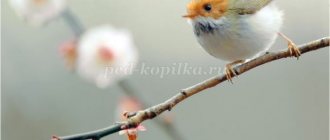MAGAZINE Preschooler.RF
FEMP lesson notes. Topic: Plan. Map.Subject. Plan (Travel Map)
Target.
1) develop the ability to navigate according to an elementary plan, correctly determine the relative position of objects in space,
2) to develop experience in overcoming difficulties independently under the guidance of a teacher,
3) consolidate the ability to identify and name the properties of objects,
4) train mental operations: analysis, comparison, attention, speech, thinking, fantasy, imagination.
Materials:
Demonstration: plan of the path to the fox's house, Cards with different locations of objects.
Progress of the lesson:
1. Introduction to the game situation.
Didactic objectives: to activate children’s knowledge about the theater, motivate them to engage in play activities.
The children gather around the teacher, the teacher asks the children if they went to the theater.
2. Updating knowledge.
Game "Buying a ticket" .
Didactic tasks: to update children’s knowledge about the theater, the ability to navigate in space, train mental operations, develop attention and speech.
Children approach the cash register.
— What should you do to buy a ticket if there are a lot of people near the ticket office? (To get in line.)
The teacher says that having bought a ticket, you need to carefully examine it, determine what is where, and then find the place where exactly such a card is located.
-Where should I go with tickets? (To the auditorium.)
The chairs in the auditorium are arranged in rows, each with 5 seats. At each place there are the same cards as one of the children has.
The task is checked for each child, and the teacher asks to tell what to find where. Tickets must be collected from children.
— Do you know how to behave in the theater?
— Why do you think it’s forbidden to make noise or talk during the performance?
-Is it possible to be late for the start of the performance?
3. Difficulty in the situation.
Game "Performance"
Didactic tasks:
- create a motivational situation for the formation of ideas about the plan and map;
- to form experience, under the guidance of a teacher, of recording difficulties and understanding their causes;
- train mental operations of analysis and comparison, strengthen children’s ability to navigate in space;
After everyone has taken their seats, the performance begins: the teacher tells a fairy tale.
(Bi-Ba-Bo toys)
— Once upon a time there was a hare and a fox. They got tired of quarreling and decided to live together. The fox invited the hare to visit.
-And where do you live? The hare asks.
First you have to go straight to the flower meadow, then turn right and go to the lonely spruce, then turn left, reach the mushroom, turn left again - and here is my home! Remember?
The hare was upset because he couldn’t remember anything.
The teacher invites the children to help the hare and tell him again how to get to the fox. A difficulty arises because the children cannot repeat the fox’s story.
- Were you able to help the hare? (no we couldn’t)
- Why couldn’t they? (because they didn’t remember the fox’s story.)
4. Discovery of new knowledge.
- form an understanding of the plan and map and the ability to navigate according to it;
- train, mental operations, analysis, comparison and generalization, speech development, logical thinking, creative abilities.
- What needs to be done so that the hare can still get to the fox’s house? Children's answers.
The teacher tells them that in order to make it easier to find the right place, people came up with a plan. On which they draw streets, houses, trees - everything that will help you find this place.
Lisa also drew a plan.
The teacher puts the plan on the board.
-What is shown on the plan?
One of the children approaches the plan and shows the road, the fox's house, a flower meadow, a pond, etc.
The teacher invites the children to use a plan to get together with the hare to the fox’s house.
The teacher helps him walk by asking leading questions: what is he walking past, what is on the right, what is on the left, in which direction he should turn.
-I walk straight, pass by a birch tree (it’s on my right), I go further, I pass by a stump (also on the right), I reach a flower field (it’s on the left), I turn right near the hedgehog, I go further, near the Christmas tree (it’s on the right), I turn left and I go to the mushroom (mushroom on the right), turn left and go to the fox’s house.
The teacher praises the children for helping the hare find the way and concludes: in order to find the road according to the plan, you need to carefully look at what is on the right and left, where you need to turn on the way to the goal.
5. Incorporation of new knowledge into the knowledge system.
Game "Pairing"
1) consolidate the ability to recognize the studied geometric shapes in objects of the surrounding world.
2) train mental operations, analysis, comparison and generalization, develop attention, speech, and communication skills.
The fox and the hare thank the children and invite them to go mushroom picking. You will have to go in pairs so as not to get lost. To divide into pairs, each child takes one card on which an object is drawn, and looks for a person who has an object on the card that has the same shape, for example: on one card there is a square Christmas tree, and on the other there are two Christmas trees, etc.
After the children are divided into pairs, the teacher asks them a question:
-What shape are your items?
Game "For mushrooms" .
Didactic tasks: consolidate the ability to navigate according to a plan, develop attention, speech, and variability of thinking.
Children, two at a time, approach easels on which there are identical plans and pencils.
— Draw a path from the house to the mushroom place.
Children independently draw a line inside the path shown on the plan.
Didactic tasks: to restore in children’s memory what they did in class, to create a situation of success.
Reflective circle. Children sit in a circle. The teacher asks questions.
-Where have you been today?
-Who did you help? -What was difficult?
The teacher praises the children and says that they were able to help the hare get to the fox’s house and were able to pick mushrooms because they know how to use a plan.
| Next > |
Game with book characters
This game can have many options: for example, you can turn it into a journey to follow your child’s favorite literary and cartoon characters.
You will need:
- laminated world map
- paper tape and scissors
- self adhesive round pads for furniture
- sheet of paper for cards
- dice
- printed figurines of book characters
- Using paper tape and stickers in the form of circles, lay out routes on a world map from your home to different parts of the world where they live:
- Malysh and Carlson (Sweden),
- Mowgli (India),
- Petson and Findus (Sweden),
- The Little Mermaid (Denmark),
- Cipollino (Italy),
- Pif dog (France),
- Paddington Bear (UK),
- Mama Mu (Sweden),
- Moomins (Finland),
- Pippi Longstocking (Sweden),
- Little Red Riding Hood (France),
- Thumbelina (Denmark),
- Karhlchen (Germany),
- Krotik (Czech Republic),
- Tsar Saltan and Prince Guidon (Russia),
- Vladimir Krasnoe Solnyshko (Ukraine),
- Totoro (Japan),
- Cinderella (France),
- Nemo fish (Australia),
- Tatu and Patu (Finland),
- Pencil and Samodelkin (Russia),
- Olivia Pig (USA),
- Karolinka (Poland),
- Karik and Valya (Russia),
- little penguin Lolo (Antarctica),
- bear cub Umka (Chukotka, Russia),
- Lion Boniface (Africa).
- Prepare cards with questions so that the child has to guess which hero we are talking about. For example, these:
- You need to move the horse from the kitchen to the balcony. Who can help you with this? (Pippi Longstocking)
- You need to build a tower using cubes and meatballs. Who can help you with this? (Carlson)
- You need to take the pies to grandma. Who can help you with this? (Little Red Riding Hood)
- You need to turn into a mosquito. Who can help you with this? (Prince Guidon)
- You need to invent a machine that takes out the things you don't like from food. Who can help you with this? (Tattoo and Patu)
- You need to sew some pants. Who can help you with this? (Mole)
- You need to defeat the poachers of Antarctica. Who can help you with this? (Lolo)
- Print out images of the desired book characters from the Internet, cut them out and place them on a world map.
- The game begins with the participants taking turns drawing a card with a task, reading what question they got, and trying to guess what kind of book character is hidden there. When the child understands who we are talking about, he must find this character on the world map. Discuss with your child the name of the country in which this book character lives, and what is interesting in this country. For example, if the player got Pippi Longstocking, talk about how many other famous book characters live in Sweden - this is Carlson, and Emil from Lenneberga, and Petson with Findus, and Nils, who traveled with the wild geese. Older children can be told about the mighty Vikings, about Charles XII, whom Peter I defeated at Poltava, etc. You can draw several task cards at once. After players guess which characters are hidden there, they need to plot the most convenient route from one hero to another and back to the start.
- When the routes are laid out, you need to roll the dice, count down the required number of moves and collect book characters from different parts of the world. The one who collects the most characters and returns home first wins.



